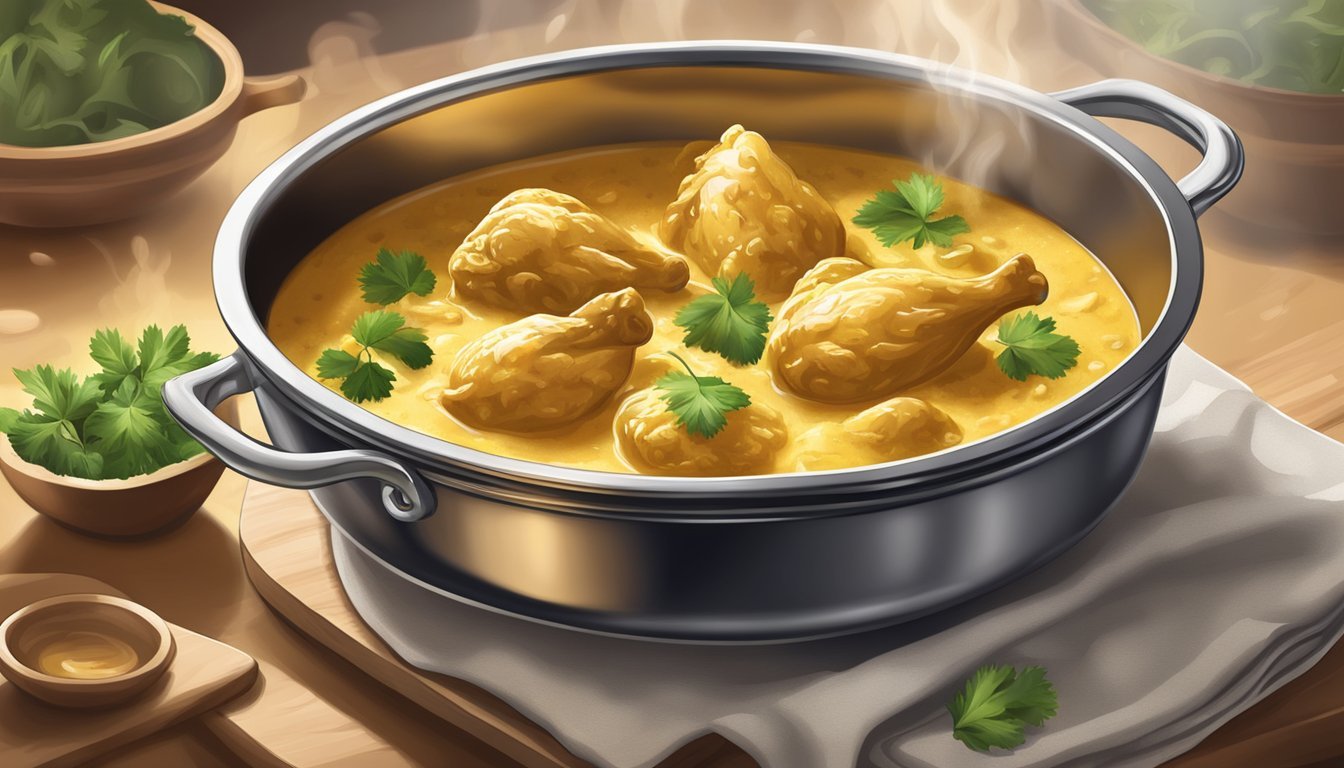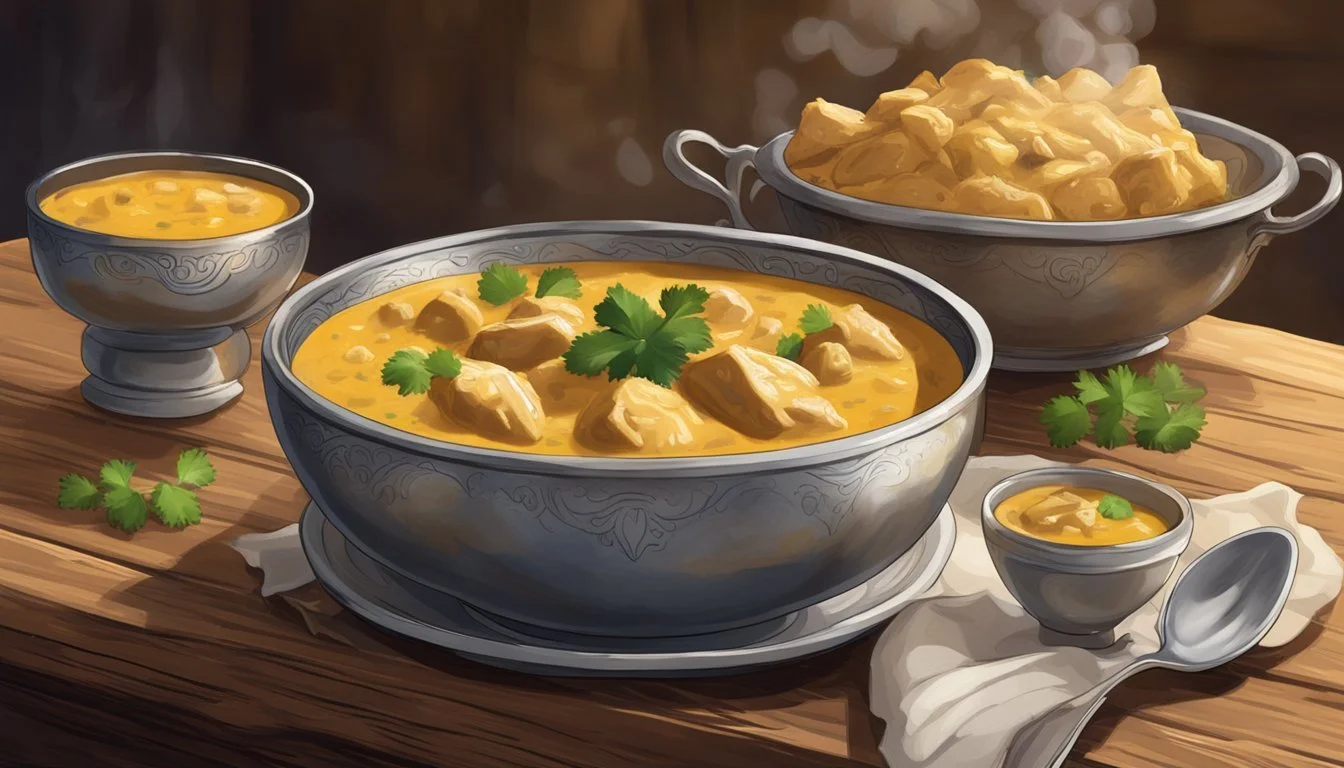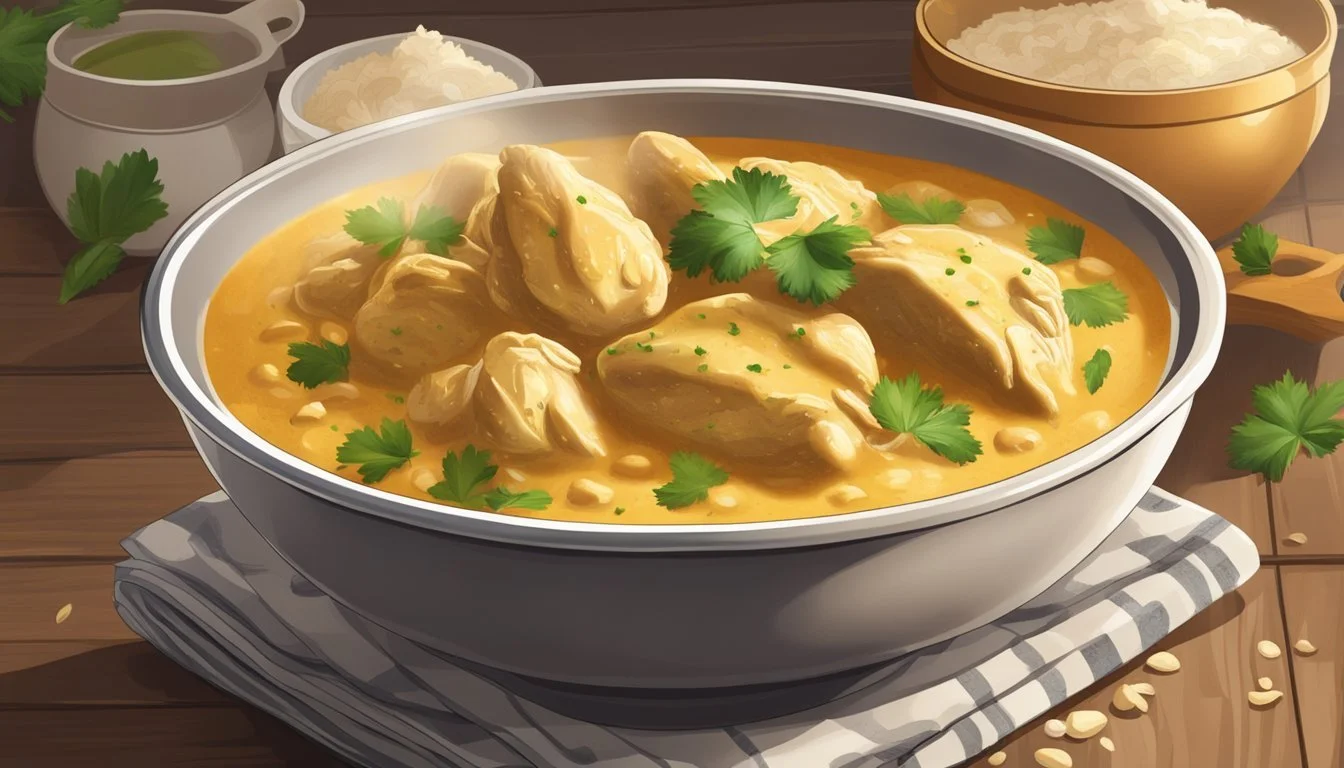Best Way to Reheat Chicken Korma
Maintaining Creaminess and Tenderness
Reheating Chicken Korma while maintaining its creaminess and tenderness is a common concern for lovers of this rich and flavorful dish. The cream-based sauce and tender pieces of chicken that characterize Korma can become dry and less appealing if not reheated properly. While the microwave might be the go-to option for its convenience, it isn't always the best choice for dishes like Chicken Korma (What wine goes well with chicken korma?) that demand a gentle touch to preserve their texture and taste.
Optimal reheating techniques involve using either the oven or the stovetop, where the heat can be carefully controlled to warm the Korma evenly without overcooking the chicken. These methods help to retain the moisture and flavor that can so easily be lost in the reheating process. It's crucial to reach a safe internal temperature, while also taking care to shield the dish from the harsh direct heat that can cause the delicate sauce to separate and the chicken to become tough.
Understanding Chicken Korma
Chicken Korma represents a culinary masterpiece, with origins steeped in history and a recipe composed of aromatic spices and key ingredients, all working together to create its signature tenderness and creaminess. Here is an exploration of its history, basic recipe components, and the vital ingredients that contribute to its authentic taste.
History of Chicken Korma
Chicken Korma is an Indian dish that has been enjoyed for centuries, with its roots tracing back to the Mughal era. The term "korma" is derived from the Urdu word for "braise," reflecting the technique commonly used in the dish's preparation. Over time, regional interpretations have led to varying versions of the korma, but its essence remains that of a rich, creamy feast, celebrated for its luxurious spices.
Chicken Korma Recipe Basics
A traditional Chicken Korma recipe involves gentle simmering of marinated chicken into an aromatic sauce that is both spicy and subdued. The process typically starts by sautéing onions, garlic, and ginger to create a flavorful base. The korma sauce, known for its creaminess, often includes yogurt, coconut milk, or cream. Here's a snapshot of the basic method:
Marinate the chicken: typically in yogurt with spices.
Sauté the base: onions, ginger, and garlic.
Braise: add chicken to the sautéed base.
Simmer: with chicken broth, and key ingredients.
Enrich: with cream, coconut milk, or yogurt to create the sauce.
Key Ingredients for Authentic Flavor
The essence of Chicken Korma lies in the symphony of spices and other components that create its unique taste:
Spices: Garam masala, coriander, cumin, turmeric, cardamom, cinnamon, and bay leaves imbue the dish with warmth and depth.
Creaminess: Yogurt, coconut cream, or Greek yogurt is crucial for a velvety korma sauce.
Nuts: Ground almonds thicken the sauce and provide texture.
Tanginess: Tomato paste balances the creaminess.
Aromatic ingredients: Onions, garlic, and ginger form the dish's flavorful foundation.
Finish: Fresh cilantro and a touch of red chili for garnish and a mild heat kick.
Pre-Reheating Tips
Proper storage and safe thawing are crucial steps in preserving the quality of leftover chicken korma before reheating. These tips ensure that the korma maintains its creaminess and tenderness when served.
Storage Tips
Before storing leftover chicken korma, one must transfer it to an airtight container to prevent the ingress of moisture or contaminants. The korma should be cooled to room temperature—ensuring it doesn’t stay out for more than 2 hours to avoid bacterial growth. Once cooled, wrap the container with plastic wrap or cover with aluminum foil for an added layer of protection before placing it in the fridge. Here’s a simple guideline:
Room Temperature Cooling Time: No more than 2 hours
Refrigeration Temperature: Below 40°F (4°C)
Max Refrigeration Time: 3-4 days for best quality
Safe Thawing Methods
If the chicken korma has been frozen, safe thawing methods are key to preventing bacterial growth and ensuring even reheating. The preferred method is to transfer the korma from the freezer to the refrigerator and allow it to thaw gradually—usually overnight. For quicker thawing, one can place the airtight container in a bowl of cold water, changing the water every 30 minutes. Avoid using hot water or leaving the korma at room temperature, as it may promote the growth of harmful bacteria.
Refrigerator Thawing Time: 24 hours for every 5 pounds of korma
Cold Water Thawing Time: Approximately 30 minutes per pound
By adhering to these pre-reheating tips, one will ensure that the chicken korma is safely stored and thawed, ready for reheating while retaining its original flavor and texture.
Reheating Chicken Korma
Proper reheating methods are crucial for maintaining the creaminess and tenderness of chicken korma leftovers. Each method varies in technique and equipment but should focus on reaching a safe internal temperature of 165°F without overcooking the dish.
Oven Method
Preheat the oven to 350°F (175°C).
Place the korma in an oven-safe dish and add a splash of water.
Cover the dish with aluminum foil to retain moisture.
Heat for 15-20 minutes or until the internal temperature reaches 165°F.
Stovetop Method
Moderate Heat: Warm a skillet on the stove over low to medium heat.
Transfer the korma to the skillet and add a bit of water or cream if necessary to avoid drying out.
Stir Frequently to ensure even heating.
Monitor until it's thoroughly warmed through and reaches the ideal temperature.
Microwave Instructions
Microwave-safe dish: Place the korma in it and cover with a lid or plastic wrap.
Heat on high for 2-3 minutes, pausing to stir every 30 seconds.
Check the temperature to ensure it's heated evenly to 165°F.
Alternative Reheating Methods
Slow Cooker
Set the slow cooker to a low heat setting.
Add the korma and a bit of water to prevent drying.
Cover and heat, checking occasionally, until hot.
Air Fryer
Preheat the air fryer to 350°F.
Place the korma in the basket and heat for a few minutes.
Shake or stir the korma halfway through to promote even reheating.
Remember, no matter the method, always check that the chicken korma has reached the safe internal temperature of 165°F to ensure food safety. Avoid excessive heat to maintain the korma's texture and flavor.
Maintaining Quality and Texture
When reheating Chicken Korma, one must focus on preserving its inherent texture and the rich, creamy consistency that makes the dish notable. The key is to gently warm the Korma without drying out the tender chicken or diminishing its fragrant flavors.
Preventing Dryness and Toughness
Bone-in vs. Boneless: Bone-in chicken tends to retain moisture better than boneless pieces. However, if using boneless, skinless chicken, include a few tablespoons of water or broth to the dish before reheating to maintain moisture.
Heating Method and Time: Carefully monitor the temperature and heating time. Overheating can cause the chicken, especially chicken breast, to become tough. For bone-in chicken, 15-20 minutes in a 350°F (175°C) oven, covered with foil, usually suffices. For boneless pieces, reduce the time accordingly to avoid overcooking.
Safeguarding Creaminess and Flavor
Microwave Reheating: Place the Korma in a microwave-safe container, loosely covering it. Heat in short intervals of 30 seconds, stirring in between to evenly distribute heat and protect the dish's creamy texture.
Richness and Spice: To protect the rich and flavorful sauce, consider adding a small amount of cream or yogurt and a pinch of sugar if the sauce has lost its balance due to refrigeration. This can help in enhancing the taste and creamy consistency.
By respecting the integrity of the ingredients and employing careful reheating techniques, one can ensure that leftover Chicken Korma remains as tender and flavorful as when it was first served.
Pairing and Serving Suggestions
When serving reheated chicken korma, selecting the appropriate side dishes and presentation techniques is critical to complement the flavors and maintain the integrity of the dish.
Side Dishes
Naan: Traditional Indian flatbread is ideal for scooping up the creamy korma sauce, providing a pleasant mix of textures.
Basmati Rice: The fragrant long grains of basmati rice act as a sponge, absorbing the richness of the korma and balancing the meal.
Breaded or Braised Cuts: For a protein-packed meal, serve with breaded chicken or braised lamb, ensuring that these additions do not become soggy in the korma sauce.
Presentation Tips
Avoiding Sogginess: To prevent soggy accompaniments, serve the rice and bread on the side rather than mixing them in with the korma.
Meal Prep: If the korma is a part of meal prep, store sides separately to retain their distinct textures.
Indian Recipes: Complement the korma with salads or pickled onions for an authentic Indian meal experience.
Advanced Techniques and Tips
Preserving the creaminess and tenderness of Chicken Korma while reheating is all about using the right methods and understanding the nuances that come into play. This section delves into techniques and practical tips to ensure that one enjoys their Korma as if it was freshly cooked.
Expert Reheating Tips
Utilize a Food Thermometer: To prevent overheating, one should use a food thermometer. Chicken Korma is best reheated when its internal temperature reaches 165°F (74°C), ensuring the chicken is safe to eat and remains succulent.
Stirring: Frequent stirring allows for even cooking and helps maintain the texture of the sauce. This technique is particularly helpful when reheating on the stove or in a microwave.
Low to Medium Heat: Reheating Chicken Korma over a gentle low to medium heat avoids burning the sauce and overcooking the chicken, keeping the dish moist and flavorful.
Add Moisture: If the Korma seems dry, adding a small amount of water before reheating can help restore its creamy consistency.
Optimizing Leftover Chicken Korma
Separate Components: When possible, one might consider reheating the sauce and chicken separately to achieve an even temperature throughout and preserve the dish's integrity.
Oven Reheating: For convenience and ease, the oven method facilitates an unattended reheating process that can deliver evenly warmed Chicken Korma. Cover the dish to retain moisture during reheating.
Boosting Flavor: Reinforce the richness of the Korma by adding a pinch of fresh spices before reheating. This can invigorate the leftover dish with a more vibrant taste.
Fast and Easy Microwave Method: In a pinch, the microwave is the fastest way to reheat Chicken Korma. Use a microwave-safe container and cover it, leaving a vent to allow steam to escape, stirring midway to heat evenly.
These advanced techniques and tips rely on both precision and an understanding of the cooking process to ensure that Chicken Korma leftovers are just as enjoyable as when they were first served.
Frequently Asked Questions
In this section, readers will find essential information addressing common concerns about reheating Chicken Korma, ensuring that the dish's creaminess and tenderness are preserved.
Can I Reheat Chicken Korma More than Once?
It is generally not recommended to reheat Chicken Korma more than once. Reheating multiple times can degrade the texture and flavor, and can also pose food safety risks. It is best practice to only reheat the quantity of Chicken Korma that will be consumed at one time.
How to Make Chicken Korma Last Longer?
Proper storage is crucial to extend the shelf life of Chicken Korma. Follow these guidelines to maximize freshness:
Cool Quickly: After initial cooking, cool the Chicken Korma quickly to prevent bacterial growth.
Airtight Containers: Transfer the Korma into airtight containers and refrigerate at or below 40°F (4°C).
Freezing: For long-term storage, freeze the Korma in appropriate freezer-safe containers or bags.
Best Practices for Reheating Without Losing Flavor
The reheating method can significantly impact the taste and texture of Chicken Korma. Here are the best practices for a flavorful result:
Oven Method:
Preheat the oven to 350°F (175°C).
Place Chicken Korma in an oven-safe dish and add a small amount of water or chicken stock to maintain moisture.
Cover with aluminum foil to retain heat and prevent drying out.
Heat until the internal temperature reaches 165°F (74°C), typically about 15-20 minutes.
Stovetop Method:
Heat Chicken Korma gently on low to medium heat in a saucepan.
Stir frequently and add a touch of water or stock if necessary to keep it moist.
Add fresh spices like ground cumin or garam masala for a flavor boost.
Remember that Chicken Korma contains delicate flavors from spices like ground almonds, ghee, and cashews, which can be sensitive to heat. Reheat gently to preserve these flavors.
Conclusion
When reheating chicken korma, one must balance maintaining its creaminess and ensuring it is heated through. The oven and stove methods are most effective for preserving the textures and flavors of the dish. Here are some takeaway points:
Oven Method: Preheat to 350°F, cover with foil, and heat for 15-20 minutes.
Stovetop Method: Reheat on low heat, stirring occasionally, and consider adding water to maintain moisture.
For each method, it is crucial that the chicken korma's internal temperature reaches 165°F to ensure food safety.
Reheating in a microwave is quick but can result in uneven heating and a potential loss of texture. If using a microwave, heat in short intervals and stir frequently.
Lastly, one may add a bit of water or broth if the korma seems dry, or a pinch of fresh spices to brighten the flavors before serving. By adhering to these guidelines, they can enjoy their chicken korma as if it were freshly made.




